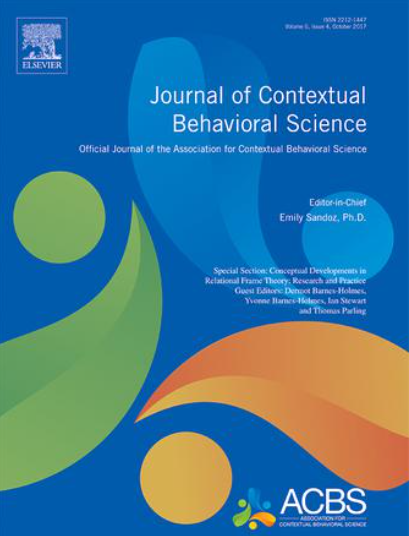Longitudinal associations between psychological flexibility and inflexibility dimensions: A cross-lagged panel network analysis
IF 3
3区 心理学
Q1 PSYCHOLOGY, CLINICAL
引用次数: 0
Abstract
Psychological flexibility (PF) and psychological inflexibility (PI) are two contrasting concepts central in acceptance and commitment therapy. The multidimensional psychological flexibility inventory (MPFI) could comprehensively assess the 12 factors of PF and PI, thus providing a measure to examine their internal relationships. In the current study, we used the cross-lagged panel network approach to explore the longitudinal associations between the 12 PF/PI components. A sample of 447 Chinese adults (mean age = 31.19, SD = 6.41) completed an online survey at two timepoints. The cross-sectional network revealed the central roles of self-as-context, defusion, fusion and experiential avoidance. The cross-lagged panel network revealed that fusion, committed action, and self-as-context were influential nodes on other dimensions, whereas inaction and defusion had high levels of predictability. The current findings shed new light on the internal structure of the PF/PI components, and elucidated nodes that were central in the cross-sectional status and longitudinal changes. The identified nodes may help inform clinicians of potential loci for intervention, and clarify the theoretical connections within the complex network of psychological flexibility processes.
心理灵活性和不灵活性维度之间的纵向关联:一个交叉滞后的面板网络分析
心理弹性(PF)和心理不弹性(PI)是接受与承诺治疗中两个截然不同的概念。多维心理灵活性量表(MPFI)可以综合评价PF和PI的12个因素,从而为检验它们之间的内在关系提供了一种手段。在本研究中,我们使用交叉滞后面板网络方法来探索12个PF/PI分量之间的纵向关联。共有447名中国成年人(平均年龄31.19岁,SD = 6.41)在两个时间点完成了在线调查。横断面网络揭示了自我作为情境、融合、融合和经验回避的核心作用。交叉滞后面板网络显示,融合、承诺行动和自我情境是其他维度上的影响节点,而不作为和融合具有高水平的可预测性。目前的研究结果揭示了PF/PI组件的内部结构,并阐明了在横截面状态和纵向变化中处于中心位置的节点。确定的节点可能有助于告知临床医生潜在的干预位点,并澄清心理灵活性过程复杂网络中的理论联系。
本文章由计算机程序翻译,如有差异,请以英文原文为准。
求助全文
约1分钟内获得全文
求助全文
来源期刊

Journal of Contextual Behavioral Science
PSYCHOLOGY, CLINICAL-
CiteScore
8.50
自引率
18.00%
发文量
82
审稿时长
61 days
期刊介绍:
The Journal of Contextual Behavioral Science is the official journal of the Association for Contextual Behavioral Science (ACBS).
Contextual Behavioral Science is a systematic and pragmatic approach to the understanding of behavior, the solution of human problems, and the promotion of human growth and development. Contextual Behavioral Science uses functional principles and theories to analyze and modify action embedded in its historical and situational context. The goal is to predict and influence behavior, with precision, scope, and depth, across all behavioral domains and all levels of analysis, so as to help create a behavioral science that is more adequate to the challenge of the human condition.
 求助内容:
求助内容: 应助结果提醒方式:
应助结果提醒方式:


